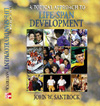 |  Life-Span Development: A Topical Approach John W. Santrock
Biological Process, Physical Development, and Health Biological Beginnings
Chapter Outline- THE EVOLUTIONARY PERSPECTIVE
- Natural Selection and Adaptive Behavior
- Evolutionary Psychology
- Evolution and Life-Span Development
- Evaluating Evolutionary Psychology
- II. HEREDITY
- What Are Genes?
- Mitosis and Meiosis
- Genetic Principles
- Dominant and Recessive Genes
- Sex-Linked Genes
- Polygenic Inheritance
- Genotype and Phenotype
- Reaction Range and Canalization
- Behavior Genetics
- Molecular Genetics
- Chromosome and Gene-Linked Abnormalities
- Chromosome Abnormalities
- Down Syndrome
- Sex-Linked Chromosome Abnormalities
- Gene-Linked Abnormalities
- Phenylketonuria
- Sickle-Cell Anemia
- Heredity-Environment Interaction
- Heredity-Environment Correlations
- Shared and Nonshared Environmental Experiences
- Conclusions About Heredity-Environment Interaction
- III. PRENATAL DEVELOPMENT
- The Course of Prenatal Development
- The Germinal Period
- The Embryonic Period
- The Fetal Period
- Prenatal Diagnostic Tests
- Amniocentesis
- Ultrasound Sonography
- Chorionic Villi Sampling
- Maternal Blood Test
- Teratology and Hazards to Prenatal Development
- Exploring Teratology
- Prescription and Nonprescription Drugs
- Psychoactive Drugs
- Alcohol
- Nicotine
- Cocaine
- Marijuana
- Heroin
- Environmental Hazards
- Other Maternal Factors
- Infectious Diseases
- Nutrition
- Emotional States and Stress
- Maternal Age
- Paternal Factors
- Positive Prenatal Development
- IV. BIRTH
- Exploring the Birth Process
- Stages of Birth
- The Transition from Fetus to Newborn
- Childbirth Strategies
- Childbirth Setting and Attendants
- Methods of Delivery
- Measures of Neonatal Health and Responsiveness
- Preterm Infants and Age-Weight Considerations
- Preterm and Low-Birthweight Infants
- Long-Term Outcomes for Low-Birthweight Infants
- Bonding
|
|



 2002 McGraw-Hill Higher Education
2002 McGraw-Hill Higher Education